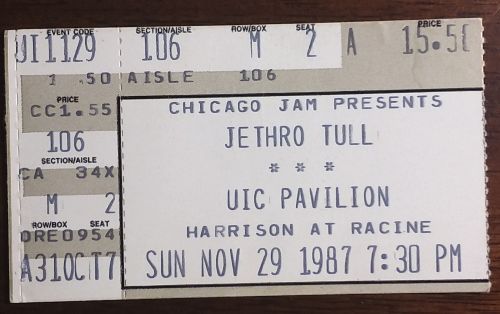Jethro Tull (or their social media person) recently asked fans via Twitter for stories about discovering the band's music. Since I rather like their music and have for a while now, I thought I'd write a little something about it.
Like a lot of people my age, I first encountered Jethro Tull on
classic rock radio in the first half of the 1980s. The way I recall it,
stations played mostly songs from Aqualung – the title track, of course,
plus "Locomotive Breath", "Hymn 43", and "Cross Eyed
Mary". I remember also hearing "Living in the Past" and "Bungle
in the Jungle". And I wouldn't doubt that I also heard "Bouree"
and that edit of "Thick as a Brick" which is basically the first 2 or 3 minutes of the piece. Perhaps "Teacher"
was in there as well. Now that I think about it, I surely heard "Skating Away
on the Thin Ice of the New Day" too. Basically, it was the standard classic
rock fare.
By that year I had been a Genesis fan for about 5 years and was
busy exploring other progressive rock bands. More than one elder proghead had
given me the "If you like old Genesis, then you need to check out…" speech. It
was an interesting year as prog stalwarts Yes, Pink Floyd, Rush, and, of
course, Jethro Tull all released albums that year. I recall seeing ads for
Tull's latest, Crest of a Knave, in Kerrang and other music zines
that I read at the time and at some point I said to myself, "Now is the
time for me to get into Jethro Tull."
I began by getting a copy of Crest of a Knave. It
seemed that most older progheads I encountered at this time were more interested
in what the band had done in the 70s. Sure, I was interested in that too but I
was also keen to hear what they were up to now because they weren't a band from
some distant point in my past – I was just a teenager – but a band that was still
around flexing their creative muscles.
While I don't recall exactly how long it took, I suspect it
was only a matter of days before I had thoroughly consumed, absorbed, and fallen in love with Crest of a Knave.
Sure, Ian Anderson's voice was quite different from what I was
accustomed to. I was unaware throat problems in 1985/86 had narrowed his range
and made it raspier, grittier. Having never heard Under Wraps at this time,
I had no conception of Crest of a Knave as having any atavistic qualities
to it. Martin Barre's guitar had never played second fiddle to keyboards, to my
ears.
While the drum machine and synths on "Steel
Monkey" brought ZZ Top's mid-80s stuff to mind, the album as a whole just
sounded like the quirky Jethro Tull that I had enjoyed on the radio as it had
plenty of loud electric guitar that was usually doing some twisty turny pas de
deux with the flute. There was the expected acoustic guitar but also a guest
violin courtesy of some gentleman named Ric Sanders. A clutch of more
straight-ahead rockers was complemented by songs like "Budapest" and
"Farm on the Freeway" which balanced acoustic and electric, fast and
slow, and loud and soft. These longer songs took melodic detours and went the scenic
route full of dynamic playing.
At this point I was completely hooked and began to seek out and
devour the rest of Tull's albums. That fall I went to see them in Chicago with a
friend of mine who was also a prog neophyte trying to catch up with the back
catalog of many a progressive rock band. While there were no codpieces to be
had, it was rockin'. The setlist had a good variety of songs from the band's
career and didn't neglect the new stuff which sat well alongside 70s classics.
I would go on to gobble up the rest of Tull's records, see the
band/Ian Anderson in concert several more times, and write a goofy essay in
which I attempted to tease out some meaning from Anderson's lyrics (or at least something meaningful to me). I was even allowed backstage before one of their shows and got to have Martin Barre and Shona
Anderson poke fun at me – all in good jest, of course. It's hard to believe it's
been 34 years since I got into Jethro Tull and discovered their music in a meaningful
way.



No comments:
Post a Comment